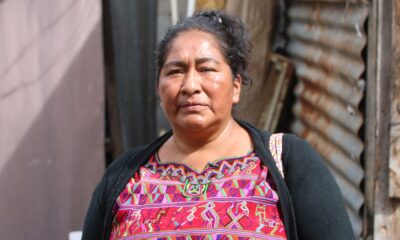Health
Rare Genetic Mutation Linked to Brain Bleeding Surges in New Mexico

A rare genetic mutation associated with brain bleeding has been identified as unusually prevalent in New Mexico. This condition, known as cerebral cavernous malformation (CCM), was highlighted in the case of Sakura Tafoya, a young girl from Santa Fe who experienced severe neurological symptoms following a soccer accident in fall 2021.
Sakura, then just four years old, attempted to perform a header during a game. Shortly thereafter, she collapsed, struggling to rise and speak. Her father, Jared Tafoya, recognized the urgency of the situation and called for medical assistance. An ambulance transported Sakura to a local hospital, where scans revealed a pool of blood on one side of her brain, caused by a cluster of fragile blood vessels.
Cerebral cavernous malformations are characterized by clusters of blood vessels that can leak, leading to a range of neurological issues, from mild headaches to severe seizures. According to estimates from the Alliance to Cure Cavernous Malformation, approximately 1 in 500 individuals have at least one malformation, with 20% of those cases inherited. In New Mexico, the occurrence of CCM is notably higher, particularly among individuals of Hispanic descent.
The genetic basis for this phenomenon lies in the CCM1 mutation, which researchers believe can be traced back to the early Spanish settlers of the region. Dr. Tarun Girotra, a neurologist at the University of New Mexico Health Sciences Center, noted that while he encountered only a few cases of CCM during his training in other states, his practice now sees it on a daily basis.
Upon arriving at Christus St. Vincent Regional Medical Center, Sakura began to seize. Her condition deteriorated rapidly, necessitating intubation and an airlift to the University of New Mexico Hospital. Her mother, Kristina Tafoya, described the days that followed as a surreal blur, as Sakura spent five days in intensive care.
Medical imaging revealed that a cluster of leaky blood vessels, only an inch below the brain’s surface, was causing her symptoms. Dr. Girotra explained that normal capillaries function as a well-designed plumbing system, but in cases of cavernous malformations, these vessels cluster together, resembling a mulberry, which compromises their integrity.
Dr. Leslie Morrison, a retired pediatric neurologist, emphasized the significance of lesions in the nervous system. “That’s bleeding into the brain tissue,” she said, underlining the potential for severe outcomes, including paralysis and even death. The inherited form of CCM can present with a variable number of lesions, with some patients having hundreds.
Sakura’s medical history is not isolated; her father had previously sought medical help for recurring headaches and was later diagnosed with CCM. This familial connection underscores the genetic nature of the condition. Dr. Morrison noted that while approximately 80% of CCM cases are sporadic, the remaining 20% are inherited in an autosomal dominant manner, meaning there is a 50% chance of transmission from an affected parent.
Surgery to treat Sakura’s brain bleed was deemed too risky due to the location of the vessels. Fortunately, her condition stabilized, and the bleeding ceased within 24 hours. Doctors prescribed medications to manage her seizures and scheduled regular MRI scans to monitor her condition.
Despite the cessation of the bleeding, Sakura’s leaky capillaries remain, as there is currently no cure for CCM. Dr. Morrison pointed out that while research is ongoing, some lifestyle changes, such as taking vitamin D supplements and maintaining healthy blood pressure, may help manage the condition.
Over the past few years, New Mexico’s legislature has allocated funding to support CCM research at the University of New Mexico, acknowledging the higher prevalence of the condition in the state.
As the Tafoya family navigates the complexities of living with this condition, Sakura continues to pursue her interests, attending third grade and dreaming of a future as a tattoo artist. Her mother, in a tribute to her daughter’s resilience, plans to get a tattoo of Sakura’s brain, using images from her medical scans as inspiration.
The Tafoyas remain vigilant about potential future bleeds, with Kristina expressing the ongoing anxiety surrounding Sakura’s condition. “The fear of her hitting her head definitely makes us hold back,” she admitted, reflecting the challenges many New Mexico families face in accessing health care amid a shortage of providers and long travel distances to specialists.
As they work to balance normalcy with caution, the Tafoyas exemplify the human impact of this rare genetic condition, highlighting the need for continued research and support for affected families in New Mexico.
-

 World5 days ago
World5 days agoExposing the Reality Behind Guatemala’s Garment Industry
-

 Politics5 days ago
Politics5 days agoLB Pharmaceuticals Quiet Period Ends October 21, Analysts Weigh In
-

 Business5 days ago
Business5 days agoRoyal Bank of Canada Upgrades Ovintiv to Outperform Rating
-

 Sports5 days ago
Sports5 days agoSaquon Barkley Reflects on James Franklin’s Dismissal from Penn State
-

 World5 days ago
World5 days agoHamas to Return Remains of Additional Hostage on Friday
-

 Health5 days ago
Health5 days agoFDA Announces First Nine Recipients of National Priority Vouchers
-

 Lifestyle3 days ago
Lifestyle3 days agoHistorian Seeks Help to Uncover Cherry Street’s Past
-

 Science5 days ago
Science5 days agoMIT Develops 3D Brain Models from Patient Cells for Custom Therapies
-

 Entertainment5 days ago
Entertainment5 days agoOlivia Nuzzi’s Memoir Set to Uncover RFK Jr.’s Controversial Texts
-

 Science3 days ago
Science3 days agoYale School of the Environment Launches Accelerated Master’s Programs
-

 Lifestyle5 days ago
Lifestyle5 days agoSouth Los Angeles Intersection Renamed to Honor Activist Danny Bakewell Sr.
-

 Entertainment5 days ago
Entertainment5 days agoSylvester Stallone’s ‘Alarum’ Surges in Streaming Despite Poor Reviews









